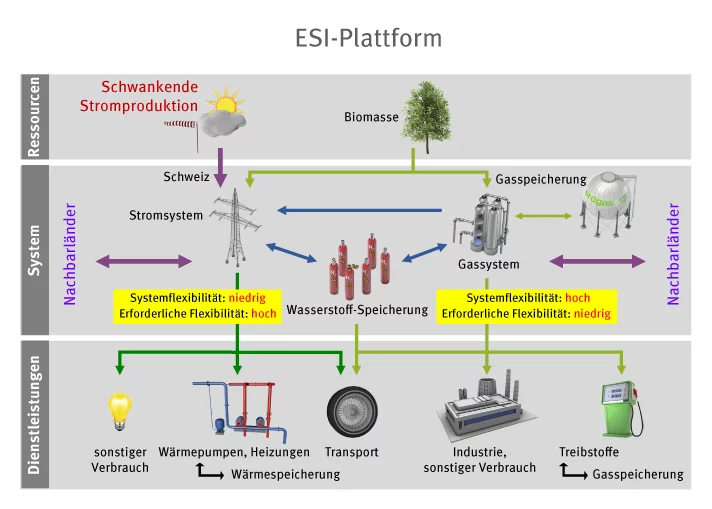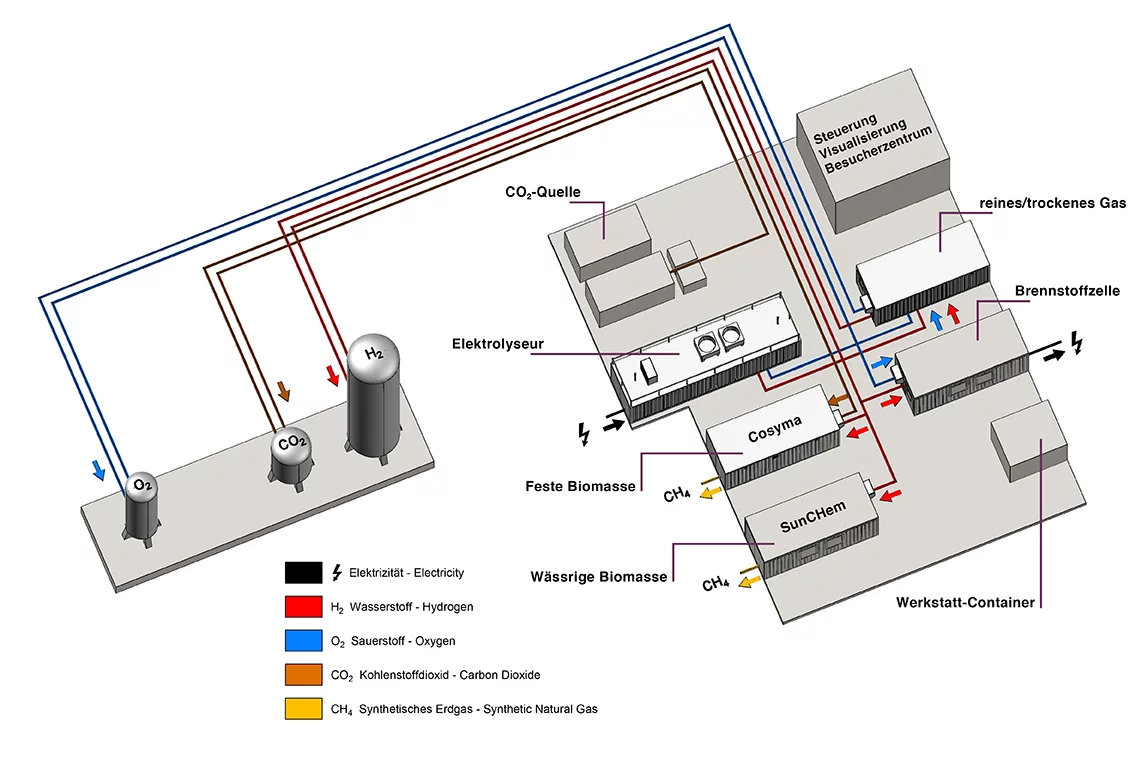The Swiss government’s Energy Strategy 2050 includes a significant expansion of renewable energy such as solar and wind power. The integration of this electric energy, which is produced in a decentralised way and with temporal fluctuations, poses a major challenge for power grids. One possible solution involves using the electricity surplus that would otherwise overload the grid for the production of gases such as hydrogen or methane. The electric energy would thus be stored temporarily in form of chemical energy. These gaseous energy carriers can be converted back into electricity, heat or kinetic energy (in gas engines) at a later date as and when needed. Dubbed “power to gas”, the concept is the focus of the new Energy System Integration (ESI) Platform at PSI.
More electricity from renewable sources should render Switzerland’s energy future more sustainable and environmentally friendly – that is one of the goals of the Swiss government’s Energy Strategy 2050. An increase in wind and solar power on the scale planned, however, poses a major challenge for the electric power grids. After all, when the wind blows strong and the sun shines bright, a surplus of electricity can be produced. The problem is that the electric power grid can only absorb as much electricity as is consumed at the same instant; otherwise, it gets out of balance and must be shut down in order to prevent damage to the electric system components. In such cases, the renewable electricity cannot be fed into the grid anymore, which is all the more regrettable as this electricity can no longer be regained when it is needed e.g. at night or during low winds – at least this is the situation until now, anyway.
Renewable energy that fails to reach the power grid is a missed opportunity to protect the climate – and an expensive one, too: network operators in the German state of Schleswig-Holstein, for example, have to pay around EUR 25 million per year in compensation as they are sometimes unable to accommodate the wind power primarily produced in the North Sea within an electric grid which is already on the verge of being overloaded.
Storing electricity in gas
The new ESI Platform at PSI is investigating one possible solution to this problem: a technology known as “powertogas”, which involves converting excess renewable electricity into an energy-rich gas such as hydrogen or methane (synthetic natural gas). This enables surplus electrical energy to be stored in the form of chemical energy. The gaseous energy carriers can be kept for a long time and transported a large distance before being converted back into electricity or heat as and when needed. Besides supplying households, commerce and industry, its usage as a fuel in mobility is also possible, such as in natural gas vehicles or fuel-cell cars – applications which PSI has been working on in collaboration with Empaon its Future Mobility Demonstrator in Dübendorf. The power-to-gas concept consists of two steps: first, the surplus electricity is used to split water into hydrogen and oxygen with the aid of an electrolyser. In the second step, the hydrogen is processed further into synthetic natural gas (methane) by adding CO2.
PSI has been researching individual components of the power-to-gas technology for many years, including polymer electrolyte membrane (PEM) materials and cathode catalysts, which form the core of the PEM electrolyser. PSI researchers have also a wide expertise in methane production– especially from biomass. And thanks to the institute’s many years of research on fuel cells, combustion engines and gas turbines, PSI also has extensive experience in technologies for the efficient conversion of the stored gases back into electricity.
Gathering experience at system level
The focus of the ESI Platform is to study all of these components in their complex interplay at the system level for the first time. The researchers’ goal is to realise a plant system with an output in the range of 100 kilowatts in order to gain system operation experience that goes beyond testing individual components. The aim of the plant is to explore the boundaries of what is technically feasible for power to gas, and the costs and possibilities of upscaling to a plant in the megawatt range. The system should also help industrial partners with an interest in power-to-gas technology to test their ideas and innovations. In this sense, the ESI platform is part of the unique services offered to companies that settle at Park InnovAARE.
Collaboration between two competence centres
Thanks to its expert knowledge and infrastructure, PSI is assuming a key nationwide role in energy research. Two of the competence centres for energy research initiated by the Swiss government within the scope of the action plan “Coordinated Energy Research Switzerland” are led by PSI (one on “energy storage” and one on “bioenergy”). One of the biggest challenges of the Energy Strategy 2050 – the incorporation of a heavily expanded electricity production from renewable energies into the grid – will now be tackled jointly by these two competence centres on the ESI Platform. As part of the projects conducted on the platform, holistic energy system analyses will be carried out, taking ecological and economic aspects into account and drawing comparisons with alternative solutions to power-to-gas.
Text: Paul Scherrer Institut/Leonid Leiva
Additional Information
Park InnovAAREContact
Prof. Dr. Alexander Wokaun, Head of the General Energy Research Department, Paul Scherrer Institute,Telephone: +41 56 310 27 51, E-Mail: alexander.wokaun@psi.ch
Dr. Peter Jansohn, Project Leader ESI Platform, Paul Scherrer Institute,
Telephone: +41 56 310 28 71, E-mail: peter.jansohn@psi.ch


